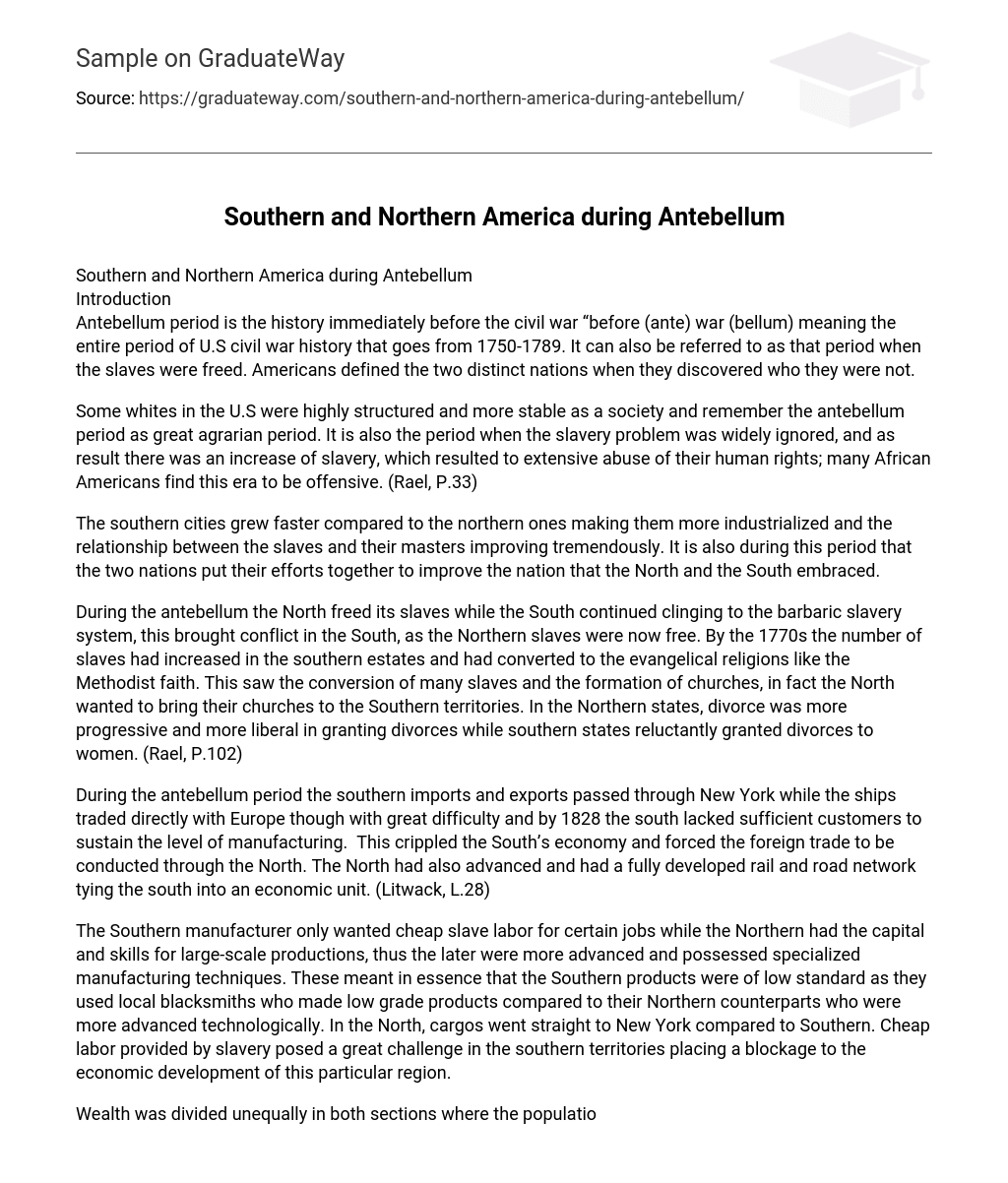Antebellum period is the history immediately before the civil war “before (ante) war (bellum) meaning the entire period of U.S civil war history that goes from 1750-1789. It can also be referred to as that period when the slaves were freed. Americans defined the two distinct nations when they discovered who they were not.
Some whites in the U.S were highly structured and more stable as a society and remember the antebellum period as great agrarian period. It is also the period when the slavery problem was widely ignored, and as result there was an increase of slavery, which resulted to extensive abuse of their human rights; many African Americans find this era to be offensive. (Rael, P.33)
The southern cities grew faster compared to the northern ones making them more industrialized and the relationship between the slaves and their masters improving tremendously. It is also during this period that the two nations put their efforts together to improve the nation that the North and the South embraced.
During the antebellum the North freed its slaves while the South continued clinging to the barbaric slavery system, this brought conflict in the South, as the Northern slaves were now free. By the 1770s the number of slaves had increased in the southern estates and had converted to the evangelical religions like the Methodist faith. This saw the conversion of many slaves and the formation of churches, in fact the North wanted to bring their churches to the Southern territories. In the Northern states, divorce was more progressive and more liberal in granting divorces while southern states reluctantly granted divorces to women. (Rael, P.102)
During the antebellum period the southern imports and exports passed through New York while the ships traded directly with Europe though with great difficulty and by 1828 the south lacked sufficient customers to sustain the level of manufacturing. This crippled the South’s economy and forced the foreign trade to be conducted through the North. The North had also advanced and had a fully developed rail and road network tying the south into an economic unit. (Litwack, L.28)
The Southern manufacturer only wanted cheap slave labor for certain jobs while the Northern had the capital and skills for large-scale productions, thus the later were more advanced and possessed specialized manufacturing techniques. These meant in essence that the Southern products were of low standard as they used local blacksmiths who made low grade products compared to their Northern counterparts who were more advanced technologically. In the North, cargos went straight to New York compared to Southern. Cheap labor provided by slavery posed a great challenge in the southern territories placing a blockage to the economic development of this particular region.
Wealth was divided unequally in both sections where the population was divided generally into rich landowners on one hand and poor laborers on the other, but voting requirements were similar. The Northern states passed individual liberty laws to oppose the fugitive slave laws that were supported by the southern territories. The northern acquired the political and economic clout and wanted to dominate the southern society as a whole.
There were activists who fought for free labor ideology that dominated in the north by 1860,however the creation of political ratification that existed in their minds and hearts made the north and the south as one people, and shared the same constitution, language and the same legal system. (Litwack, L.55)
The northern states mainly relied on the home market for the supply of the products they produced while the south majored mainly in the export trade, this lead to the improvement of the north’s economy during the antebellum period. (Rael, P.77) During the industrialization the south home markets were dealing mainly with foodstuffs from the west and manufactured goods from the east. Some parents from south sent their children to the north. The growth of higher education kept cities and towns with colleges and academies including the ones in Opelousas in the south where women rarely had any formal education and when they did they were separate from the men folk.
Conclusion
The north and the south territories were quite distinct from each other; and all the difference stemmed from their differences in the use of slaves for labor. These differences have gone a long way in determining the future of the United States as a country. The differences that came to fore during the antebellum would be one of the main fuels for the American Civil War which brought America close to a total collapse of the United States of America.
Work cited
- Litwack, Leon: North of South: The Negro in the Free States 1790-1860. Chicago: The University P 28- 90
- Rael, Patrick. Black Identity and Black Protest in the Antebellum North. Chapel Hill and London: The University of North Carolina Press, 2002 P 33-102.





